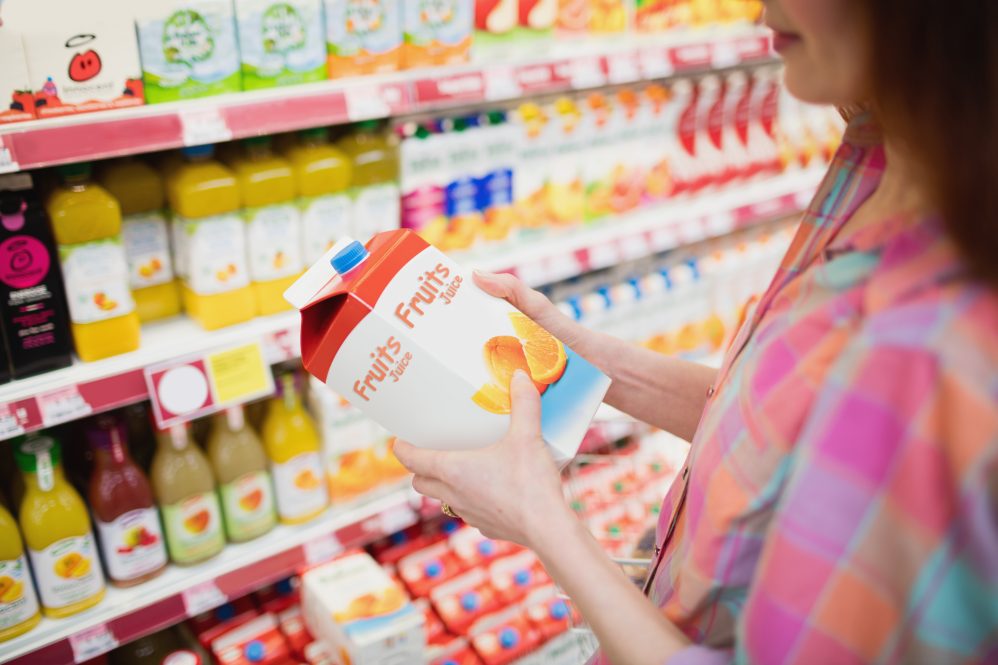Current labeling regulations and practices fail to give parents and caregivers adequate information, and likely contribute to widespread consumption of sugar-sweetened drinks by young children, according to a new paper from researchers at the Rudd Center for Food Policy and Obesity at the University of Connecticut and School of Global Public Health at New York University. The study’s findings, published in Pediatric Obesity, revealed that when shown product packages and nutrition labels for the most popular children’s drinks, the majority of parents of young children cannot identify key ingredients in these drinks, including added sugars, diet sweeteners (also known as no-/low-calorie or high-intensity sweeteners), and/or the percentage of juice in the drink.
In an online experiment, researchers showed packages of eight popular children’s drinks, including sweetened fruit drinks and flavored waters and unsweetened 100% juice and juice/water blends, to 1,603 U.S. parents with young children (1-5 years old). Parents viewed either the front-of-package alone or the front-of-package with the information panel, which includes the nutrition facts panel and ingredient list. Researchers also provided participants with common statements of identity found on children’s drinks, such as “water beverage,” “fruit-flavored drink,” or “100 percent juice.” The statement of identity is prominently displayed on the front of the package and is supposed to provide consumers with an appropriately descriptive name to identify the type of product.
The majority of parents (62%) could not identify most drinks that contained diet sweeteners, even when shown the information panel with nutrition and ingredient information. They also overestimated the average percent juice content in sugar-sweetened drinks, believing that these drinks contained 22% juice, when they actually contained 3% juice on average. Moreover, approximately one-third of parents (37%) believed that products labeled “100% juice” contained less than 100% juice.
In addition, parents were more likely to believe that statements of identity with the words “natural” and “water beverage” meant the drink did not contain added sugar or diet sweeteners and did contain juice, although they are commonly used on children’s flavored water drinks that contain added sugar, diet sweeteners, and no juice.
“Child health experts recommend that young children should not consume products that contain added sugars or diet sweeteners, yet many of the most popular children’s fruit drinks and flavored waters contain both,” says Jennifer Harris, the study’s lead author and senior research advisor, marketing initiatives, at the UConn Rudd Center. “Children’s drink packages should provide clear and easy-to-understand ingredient information on the package front to help parents choose healthier drinks for their children. Our study shows that current labeling practices fall short and can mislead parents about what’s really in the drinks they serve their young children.”
Additional key findings include:
- The majority of parents (84%) accurately identified products that contained added sugar when viewing front-of-packages alone.
- Compared to parents who only viewed the front-of-package, those who viewed the information panel with nutrition and ingredient information were significantly more likely to accurately identify the ingredients in most drinks, ranging from 4 percent more likely to identify sugar-sweetened drinks to 31 percent more likely to identify drinks with diet sweeteners.
- However, even with the nutrition information and ingredient list on the information panel, 53% of participants incorrectly believed that unsweetened 100% juice and/or juice/water blends contained added sugar.
- Most parents were familiar with and had purchased the drinks included in the study and felt confident in their ability to identify added sugars (69%) and juice content (64%) in the children’s drinks. In contrast, less than one-half (48%) were confident in their ability to identify diet sweeteners in these drinks.
The American Academy of Pediatrics (AAP) and other leading health organizations recommend that young children should not consume sugary drinks or products that contain diet sweeteners (also known as high-intensity sweeteners). Recently released U.S. Dietary Guidelines for infants and toddlers also recommend against products with added sugar or diet sweeteners for children under age 2. However, 25% of 1- to 2-year-olds and 45% of 2- to 4-year-olds in the United States consume sugary drinks on a given day.
As this study shows, current labeling of sweetened fruit drinks and flavored waters as well as unsweetened juices does not provide adequate information for parents to identify healthier drinks for their children. These findings demonstrate the need for updated regulations to require clear disclosures of added sugar, diet sweeteners, and juice content on the front of product packages.
The study was co-authored by Jennifer L. Pomeranz, JD, MPH of NYU’s School of Global Public Health and funded by a grant from the Robert Wood Johnson Foundation. The views expressed in this report do not necessarily reflect the views of the Foundation.



